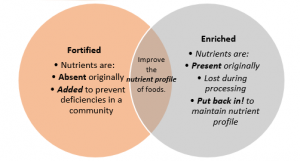Enriched and Fortified Food - What is It


Written and verified by the nutritionist Eliana Delgado Villanueva
If you read the food labels when you go shopping you’ll often see they’re either enriched or fortified or both. OK, but what exactly does that mean? What’s the difference between one and the other? Are these food items truly good for your health, as opposed to buying those which aren’t?
From dairy and noodles to personal hygiene products, there are many with added vitamins, minerals and other nutrients that make them “healthier.” In this article, we’ll tell you what enriched and fortified food is what’s the difference between them.
What exactly is enriched and fortified food

The World Health Organization (WHO) published Guidelines on Food Fortification with Micronutrients. This is a guideline on nutrition from a public health perspective, mainly to provide a practical guide to nutrition-related public health program managers. However, it should also be useful to all those working to control micronutrient malnutrition, including the food industry, as well as anyone who needs to implement, monitor and evaluate fortification methods.
According to regulations, enriched and fortified food must indicate it is so on the food label.
Fortified food is that to which one or more natural substances have been added. Be it because the original amount of a nutrient was minimal to begin with, or because it disappears during processing.
It’s a common practice to add higher amounts of micronutrients than those contained in the original food. For instance, milk contains vitamin D, although in limited quantity. So, the milk is then enriched with this vitamin while processing it. Wheat is another, as it loses a large part of its vitamins during processing. The food industry uses this practice frequently to make up for lost nutrients.
You may want to read: Who Tends to Be Vitamin D Deficient?
Why does food need to be enriched and fortified

The main advantage of fortification and enrichment, compared to other methods that can increase the micronutrient content of the diet, is that they don’t require people to change their eating habits.
Fortification helps increase the intake of micronutrients so that the population doesn’t have to modify their normal diet. This benefits all sectors of the population, especially those living in areas with limited resources.
Examples of the importance of enriched and fortified food
The decline in iodine deficiency in several countries is the first success story of food fortification. Iodine is necessary for the formation of thyroid hormones. These are responsible for regulating growth and metabolic processes.
This kind of deficiency results in intellectual disability and congenital hyperthyroidism in infants and children, or goiter in adults. Iodine is usually present in seafood, such as fish, shellfish and seaweed. So, people who live near the sea rarely have an iodine deficiency problem.
The first examples of an effective iodine program took place in Switzerland and in the state of Michigan.
Read also: Seven Iodine Packed Beverages to Improve Thyroid Function
Folic acid and neural tube defects
At the beginning of the 70s, the possible relationship between nutrition and the incidence of neural tube defects was already clear. This is a type of defect that affects the proper development of the brain, spinal cord, or spine of an embryo.
In the mid-1970s, this relationship between folic acid and congenital defects was already the basis for the first clinical studies. They demonstrated that folic acid supplementation is an effective way to reduce the incidence of neural tube defects.
Finally, we recommend the supervision of regular fortified food consumption by a nutritionist, in order to avoid excess food intake.
All cited sources were thoroughly reviewed by our team to ensure their quality, reliability, currency, and validity. The bibliography of this article was considered reliable and of academic or scientific accuracy.
- Allen, L. H., De Benoist, B., Dary, O., & Hurrell, R. (2017). Guías para la fortificación de alimentos con micronutrientes.
- Smithells RW, Sheppard S, Schorah CJ. Vitamin deficiencies and neural tube defects. Arch Dis Child. 1976 Dec;51(12):944-50. PubMed PMID: 1015847; PubMed Central PMCID: PMC1546171.
- Zimmermann MB. Research on iodine deficiency and goiter in the 19th and early 20th centuries. J Nutr. 2008 Nov;138(11):2060-3. PubMed PMID: 18936198.
- Czeizel, A.E., et al., Prevention of neural-tube defects with periconceptional folic acid, methylfolate, or multivitamins? Ann Nutr Metab, 2011. 58(4): p. 263-71.
This text is provided for informational purposes only and does not replace consultation with a professional. If in doubt, consult your specialist.








